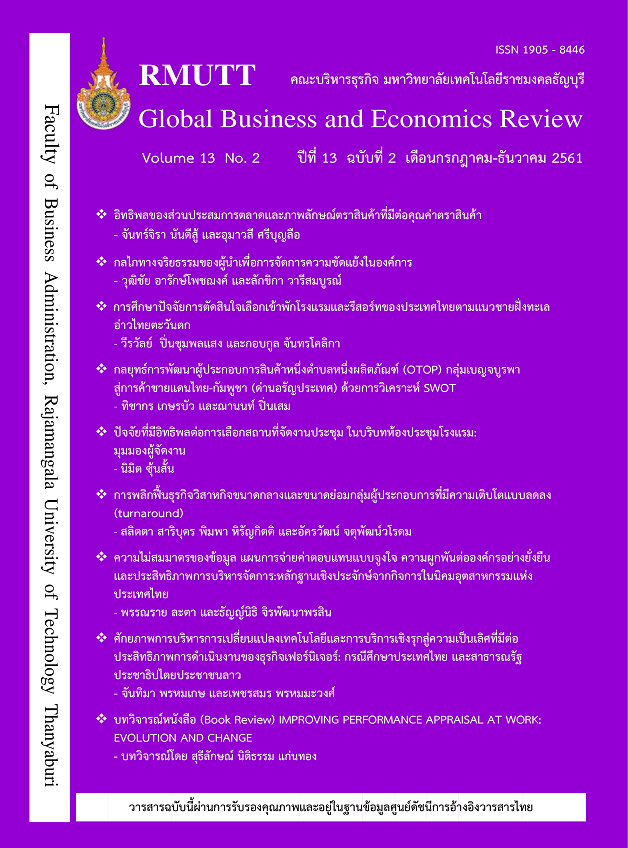THE INFLUENCE OF MARKETING MIX AND BRAND IMAGE ON BRAND EQUITY
Keywords:
Marketing Mix, Brand Image, Brand EquityAbstract
This objective of this research was to study the influence of marketing mix and brand image on brand equity. The samples used in this study were FUJI FLM or OLYMPUS mirrorless camera users in Bangkok Metropolitan area. The statistics used for data analysis were frequency, percentage, mean, and hypothesis testing including independent samples t-test, Simple Regression Analysis, and Multiple Regression Analysis at a significance level of 0.05. The research results revealed that the majority of respondents were female (69.00%), aged between 21-30 years. (80.75%), held a bachelor's degree (88.75%), worked as employees at private companies (64.25%), and received monthly income between 15,0001-25,000 baht (64.25%). Moreover, it was found that marketing mix, brand image, and brand equity were at the highest level with averages of 4.64, 4.84, and 4.74 respectively. The results of hypothesis testing revealed that marketing mix and brand image correlated with brand equity. The results of multiple regression analysis also showed that marketing mix and brand image influenced brand equity. Finally, differences in brand significantly caused different perceptions in marketing mix, brand image, and brand equity at a significance level of 0.05.
References
จักรพันธ์ อุพันวัน. (2556). คุณค่าตราสินค้าและความต้องการในการใช้นาฬิกาแบรนด์เนมที่ส่งผลต่อการตัดสินใจซื้อนาฬิกา G-SHOCK ของผู้บริโภคในเขตกรุงเทพฯ. (การค้นคว้าอิสระปริญญามหาบัณฑิต, มหาวิทยาลัยกรุงเทพ).
ชูศรี วงศ์รัตนะ. (2541). การวิจัยเพื่อการเรียนรู้. กรุงเทพฯ: เมธีทิปส์. ตลาดกล้องดิจิทัล. (2559). สืบค้นจาก http://marketeer.co.th
ธนัตถ์ สุขประเสริฐ. (2559). ปัจจัยที่ส่งผลต่อการตัดสินใจเลือกซื้อกล้องติดรถยนต์ของผู้ใช้รถใช้ถนนในเขตกรุงเทพฯ และปริมณฑล. (การค้นคว้าอิสระปริญญามหาบัณฑิต, มหาวิทยาลัยธรรมศาสตร์).
นภัสกร ศักดานุวงศ์. (2545). การวัดคุณค่าตราสินค้าในตลาดที่มุ่งสู่องค์กรธุรกิจ. กรุงเทพฯ: ฐานข้อมูลวิทยานิพนธ์ไทย.
ภัทร์จิรา ศรวิชัย. (2557). การรับรู้ภาพลักษณ์ของร้านค้าสะดวกซื้อเซเว่นอีเลฟเว่น (7-Eleven) ของผู้บริโภคในเขตกรุงเทพฯ. (การค้นคว้าอิสระปริญญามหาบัณฑิต, มหาวิทยาลัยเทคโนโลยีราชมงคลธัญบุรี).
ศิวบูรณ์ ธนานุกูลชัย. (2554). ภาพลักษณ์ตราสินค้ามีผลต่อการตัดสินใจซื้อรถยนต์มือสองค่ายญี่ปุ่นของผู้บริโภคในเขตกรุงเทพฯ. (การค้นคว้าอิสระปริญญามหาบัณฑิต, มหาวิทยาลัยกรุงเทพ).
ศิริวรรณ เสรีรัตน์ และคณะ. (2552). การบริหารการตลาดยุคใหม่. กรุงเทพฯ: เพชรจรัสแสงธุรกิจ.
โสภิตา รัตนสมโชค. (2558). ปัจจัยส่วนประสมทางการตลาด (7Ps) ที่มีอิทธิพลต่อความพึงพอใจในการใช้บริการรถไฟฟ้าเฉลิมพระเกียรติ (บีทีเอส)ของประชากรในเขตกรุงเทพฯ. (การค้นคว้าอิสระปริญญามหาบัณฑิต, มหาวิทยาลัยธรรมศาสตร์).
อลงกรณ์ กริชนิกร. (2558). การรับรู้ ความพึงพอใจ และปัจจัยส่วนประสมทางการตลาดที่มีผลต่อความภักดีต่อตราฟูจิฟิล์มของลูกค้าในกรุงเทพฯ. (การค้นคว้าอิสระปริญญามหาบัณฑิต, มหาวิทยาลัยกรุงเทพ).
Brandage. (2560). Smartphone Killer ตายเรียบกล้อง คอมแพคท์. สืบค้นจาก http://www.brandage.com/article/364/Smartphone-Killer
Brandage. (2561). ฟูจิฟิล์ม สานต่อ “Find Your Wonder-side” เปิดตัวกล้อง X-A5 กับ Brand Ambassador สุดฮอต BNK 48. สืบค้นจาก http://www.brandage.com/article/3600/X-A5-
Abdolv, M. A. & Alinejad, S. (2013). Using the STRATADAPT scale to measure marketing mix strategy in international markets. Research Journal, 5(13), 3499-3507.
Amini, A, et al. (2012). Effectiveness of marketing strategies and corporate image on brand equity as a sustainable competitive advantage. Research Journal in business, 4(2), 192-205.
Armstrong, G. & Kotler, P. (2009). Marketing: an introduction (9th ed.). Upper Saddle River, NJ: Prentice Hall.
Dmour, H. A, & et al. (2013). The effect of services marketing mix elements on customer-based brand equity : an empirical study on mobile telecom service recipients in Jordan. International Journal of Business and Management, 8(11), 13-26.
Fatema, M., Azad, A. K., & Masum, A. K. (2013). Impact of brand image and brand loyalty in measuring brand equity of Islami Bank Bangladesh Ltd. Asian Business Review, 2(3).
Field, A. (2005). Discovering statistics using SPPS (2nd ed.). London, Thousand Oaks, New Delhi: SAGE Publications Ltd.
Keller, K. L. (2008). Strategic brand management: Building, measuring, and managing brand equity. (3rd ed.). Upper Saddle River, NJ: Prentice Hall.
Kim, J. H. & Hyun, Y. J. (2010). A model to investigate the influence of marketing-mix efforts and corporate image on brand equity in the IT software sector. Industrial Marketing Management, 40(3), 424-438.
Suppapanya, P., & Boonkert, S. (2010). Comparing brand equity of digital single lens reflex (DSLR). kku research journal, 15(30), 768-777.
Subramaniam, A. & Mamun, A. A., & et al. (2014). Effects of brand loyalty, image and quality on brand equity: a study among bank Islam consumers in Kelantan, Malaysia. Asian Social Science, 10(14), 67-73.
Yoo, B., Donthu, N., & Lee, S. (2000). An examination of selected marketing mix elements and brand equity. Journal of the Academy of Marketing Science, 28(2), 195-211.
Yoo, B., & Donthu, N. (2001). Developing and validating a multidimensional consumer-based brand equity scale. Journal of Business Research, 52(1), 1-14.
Downloads
Published
How to Cite
Issue
Section
License
The articles published in this journal are the intellectual property of their respective authors.
The views and opinions expressed in each article are solely those of the individual authors and do not reflect the positions of Rajamangala University of Technology Thanyaburi or any of its faculty members. All components and content of each article are the sole responsibility of the respective authors. In the event of any errors, the authors shall bear full responsibility for their own work.








